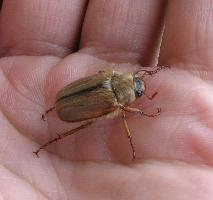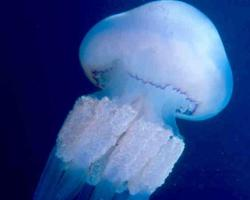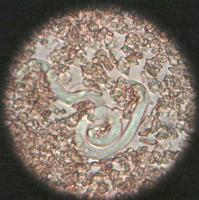
Állatleírás
The Feline roundworm, scientifically known as Toxocara cati, is a parasitic nematode that predominantly infects domestic cats, although it can also be found in wild feline populations. This parasitic worm is of significant concern due to its potential impact on pet health and its zoonotic potential, meaning it can be transmitted from animals to humans, particularly to children, causing a condition known as toxocariasis.Adult T. cati worms are typically long, slender, and whitish in color, measuring about 3 to 10 cm in length. They reside in the small intestine of their feline hosts, where they attach to the intestinal lining to feed on blood, tissue fluids, or the host's ingested food. The presence of these parasites can lead to a range of health issues in cats, including malnutrition, intestinal blockage, and poor growth in kittens.
The life cycle of T. cati is complex and can be completed within the feline host or involve intermediate hosts such as rodents, birds, and even earthworms. Cats become infected by ingesting the infective eggs from the environment, consuming an intermediate host that harbors larval stages of the parasite, or through the transmammary route, where larvae are transmitted from an infected mother cat to her kittens through her milk.
Eggs of T. cati are remarkably resilient and can survive in the environment for months to years under favorable conditions, waiting to be ingested by a suitable host. Once ingested, the eggs hatch in the cat's intestine, releasing larvae that migrate through various tissues, including the liver and lungs, before returning to the intestine to mature into adult worms. This migration can cause tissue damage and contribute to the clinical signs associated with infection.
In humans, toxocariasis typically occurs after accidental ingestion of infective T. cati eggs from contaminated soil, hands, or food. Children are particularly at risk due to their play habits. The disease in humans can range from asymptomatic to causing serious conditions such as visceral larva migrans (VLM), where the larvae migrate through and damage internal organs, or ocular larva migrans (OLM), where the larvae invade the eye and can cause vision loss.
Control and prevention of T. cati infection involve regular deworming of cats, especially kittens and nursing queens, proper disposal of cat feces, and preventing cats from hunting. Public health measures include educating the public about the risk of toxocariasis, promoting handwashing, especially in children, and maintaining clean play areas.
In summary, Toxocara cati is a parasitic roundworm of major veterinary and public health importance. Its ability to infect cats and potentially humans, combined with the resilience of its eggs in the environment, underscores the need for comprehensive strategies to control its spread and minimize the risk of human infection.
Hasonló állatok
Új állatfotók
Top 10 állat
- Dolphin gull (Leucophaeus scoresbii)
- Diana monkey (Cercopithecus diana)
- Moustached guenon (Cercopithecus cephus)
- Galápagos tortoise (Geochelone nigra complex)
- Japanese macaque (Macaca fuscata)
- Stone loach (Barbatula barbatula)
- Russian tortoise (Testudo horsfieldii)
- Greek tortoise (Testudo graeca)
- Common flying dragon (Draco volans)
- Vendace (Coregonus albula)


